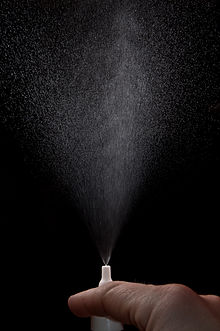| Revision as of 16:23, 13 October 2019 editBoghog (talk | contribs)Autopatrolled, Extended confirmed users, IP block exemptions, New page reviewers, Pending changes reviewers, Rollbackers, Template editors137,738 edits added missing details to cites← Previous edit | Revision as of 11:50, 26 October 2019 edit undoIztwoz (talk | contribs)Extended confirmed users, New page reviewers74,456 edits →See also: added itemNext edit → | ||
| Line 20: | Line 20: | ||
| *] | *] | ||
| *] | *] | ||
| *] | |||
| == References == | == References == | ||
Revision as of 11:50, 26 October 2019
For the scientific journal, see Drug Delivery (journal).
Drug delivery refers to approaches, formulations, technologies, and systems for transporting a pharmaceutical compound in the body as needed to safely achieve its desired therapeutic effect. It may involve scientific site-targeting within the body, or it might involve facilitating systemic pharmacokinetics; in any case, it is typically concerned with both quantity and duration of drug presence. Drug delivery is often approached via a drug's chemical formulation, but it may also involve medical devices or drug-device combination products. Drug delivery is a concept heavily integrated with dosage form and route of administration, the latter sometimes even being considered part of the definition.
Drug delivery technologies modify drug release profile, absorption, distribution and elimination for the benefit of improving product efficacy and safety, as well as patient convenience and compliance. Drug release is from: diffusion, degradation, swelling, and affinity-based mechanisms. Some of the common routes of administration include the enteral (gastrointestinal tract), parenteral (via injections), inhalation, transdermal, topical and oral routes. Many medications such as peptide and protein, antibody, vaccine and gene based drugs, in general may not be delivered using these routes because they might be susceptible to enzymatic degradation or can not be absorbed into the systemic circulation efficiently due to molecular size and charge issues to be therapeutically effective. For this reason many protein and peptide drugs have to be delivered by injection or a nanoneedle array. For example, many immunizations are based on the delivery of protein drugs and are often done by injection. Protein drugs delivered by injection can usually reach the extracellular space. Many approaches have been evaluated for targeting the intracellular space with protein drugs but delivering proteins into cells (e.g. into the cytosol) is still challenging.
Current efforts in the area of drug delivery include the development of targeted delivery in which the drug is only active in the target area of the body (for example, in cancerous tissues), sustained release formulations in which the drug is released over a period of time in a controlled manner from a formulation, and methods to increase survival of peroral agents which must pass through the stomach's acidic environment. In order to achieve efficient targeted delivery, the designed system must avoid the host's defense mechanisms and circulate to its intended site of action. Types of sustained release formulations include liposomes, drug loaded biodegradable microspheres and drug polymer conjugates. Survival of agents as they pass through the stomach typically is an issue for agents which cannot be encased in a solid tablet; one research area has been around the utilization of lipid isolates from the acid-resistant archaea Sulfolobus islandicus, which confers on the order of 10% survival of liposome-encapsulated agents.
See also
- Thin film drug delivery
- Magnetic drug delivery
- Self-microemulsifying drug delivery system
- Acoustic targeted drug delivery
- Neural drug delivery systems
- Drug delivery to the brain
- Drug carrier
- Bovine submaxillary mucin coatings
- Retrometabolic drug design
- Bioavailability
- Asymmetric membrane capsule
- Tecrea
References
- "Drug Delivery Systems (definition)".
- "Drug delivery - definition of drug delivery by Medical dictionary". TheFreeDictionary.com.
- Smart Materials for Drug Delivery Set, Editors: Carmen Alvarez-Lorenzo, Angel Concheiro, Royal Society of Chemistry, Cambridge 2013, https://pubs.rsc.org/en/content/ebook/978-1-84973-552-0
- Wang NX, von Recum HA (March 2011). "Affinity-based drug delivery". Macromolecular Bioscience. 11 (3): 321–32. doi:10.1002/mabi.201000206. PMID 21108454.
- "Common Routes of Drug Administration". Intro to Pharmacology. Eugene, Oregon: Lane Community College. Retrieved 2018-10-04.
- "The administration of medicines". Nursing Times. 2007-11-19. Retrieved 2018-10-04.
- Marschall AL, Frenzel A, Schirrmann T, Schüngel M, Dübel S (2011). "Targeting antibodies to the cytoplasm". mAbs. 3 (1): 3–16. doi:10.4161/mabs.3.1.14110. PMC 3038006. PMID 21099369.
- Marschall AL, Zhang C, Frenzel A, Schirrmann T, Hust M, Perez F, Dübel S (2014). "Delivery of antibodies to the cytosol: debunking the myths". mAbs. 6 (4): 943–56. doi:10.4161/mabs.29268. PMC 4171028. PMID 24848507.
- Bertrand N, Leroux JC (July 2012). "The journey of a drug-carrier in the body: an anatomo-physiological perspective". Journal of Controlled Release. 161 (2): 152–63. doi:10.1016/j.jconrel.2011.09.098. PMID 22001607.
- Staff (2015). "Acid-friendly Microbe Finds Application in Drug Delivery". American Laboratory (paper). Vol. 47, no. 9. p. 7. ISSN 0044-7749.
External links
| Topics in medicinal chemistry | |
|---|---|
|





